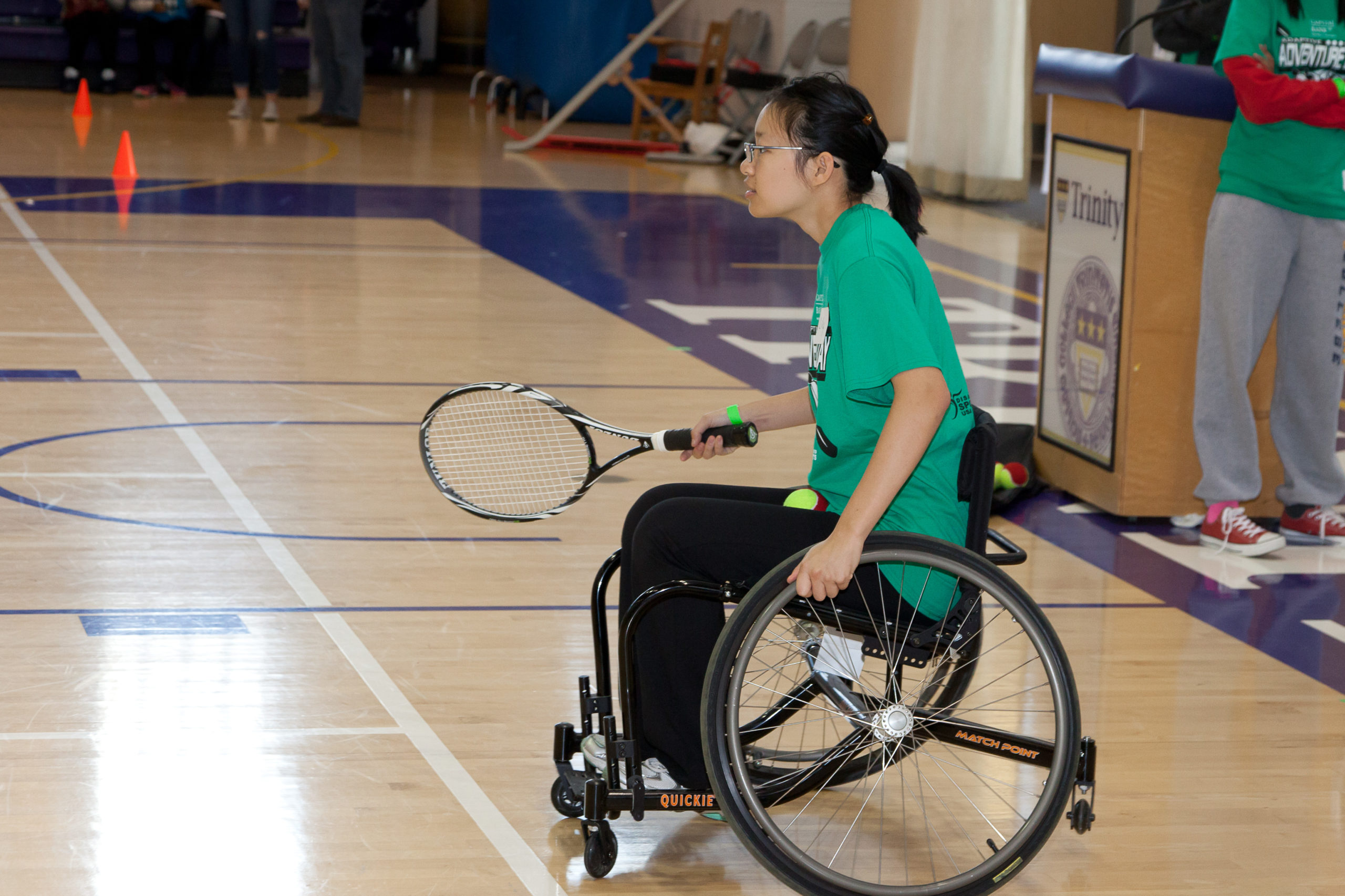
Tennis/Wheelchair Tennis
Optimism IN the Face of Challenge
The people you meet through tennis are friendly, happy, optimistic and outgoing, They just want to have a good time and want others to have a good time.
– Steve Kappes, Director of the San Diego Wounded Warrior Tennis Program and Director of Military Outreach for the San Diego District Tennis Association
All About Tennis
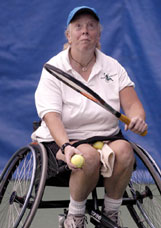 With more than 250,000 courts in communities across the U.S., tennis is a widely accessible sport that more than 15 million Americans love to play, from young children to people in their 80s. One reason why tennis is so popular is because it’s a sport that is very social, both on and off the court, through tennis clubs and leagues. “In addition to the benefits of getting outside, becoming active and exercising, many of the participants like just as much meeting people, forming friendships and connecting to a tennis community that can be like a second family” said Steve Kappes, Director of the San Diego Wounded Warrior Tennis Program and Director of Military Outreach for the San Diego District Tennis Association. With tennis, you can choose to play the occasional, neighborhood 30-minute game recreationally or play in competitive matches that can last hours. Fortunately, tennis offers numerous adaptations in instruction and equipment that allow youth and adults of all abilities to play.
With more than 250,000 courts in communities across the U.S., tennis is a widely accessible sport that more than 15 million Americans love to play, from young children to people in their 80s. One reason why tennis is so popular is because it’s a sport that is very social, both on and off the court, through tennis clubs and leagues. “In addition to the benefits of getting outside, becoming active and exercising, many of the participants like just as much meeting people, forming friendships and connecting to a tennis community that can be like a second family” said Steve Kappes, Director of the San Diego Wounded Warrior Tennis Program and Director of Military Outreach for the San Diego District Tennis Association. With tennis, you can choose to play the occasional, neighborhood 30-minute game recreationally or play in competitive matches that can last hours. Fortunately, tennis offers numerous adaptations in instruction and equipment that allow youth and adults of all abilities to play.
Tennis for Veterans
Adaptive tennis opportunities are available to veterans of all ages with disabilities too. “Tennis is a lifelong sport. We serve veterans who have recently served to veterans who served in World War Ii. This is because we can adjust what we do to accommodate whatever their ability level is,” Kappes said. “It’s all about having fun, where you will meet people interested in your well-being and happiness,” he said. “We want people to keep coming back for more. We offer tennis in the most accommodating, supportive way possible. Family members and friends are encouraged to join veterans at clinics to have someone close to them with whom they can play.” VA hospitals have a recreation department or therapist on staff running adaptive sports programs, including tennis.
Wheelchair Tennis

Since its beginnings in 1976, wheelchair tennis has grown from an exhibition event to an officially-recognized Paralympic sport since 1988. But a player doesn’t need the skill level of a Paralympian to enjoy the sport. In wheelchair tennis, the only rule change is that the player gets two bounces, if needed. More than 100 competitors from around the world competed in the Rio Paralympics in 2016, including U.S. athlete David Wagner who earned a bronze medal and is currently ranked No. 2 in the world. “It [wheelchair tennis] is something I can do with my able-bodied friends.” Wagner told Gillette World Sport. “It’s pretty inclusive of all disabilities whether you are standing or sitting.” “Tennis works very well for people with different disabilities. Lessons can be catered to anyone’s ability, so we can ensure our participants have success,” said Richard Spurling, founder and board president of Aceing Autism, a nonprofit providing children with autism spectrum disorders opportunities to play tennis. Aceing Autism serves more than 650 children with autism across 45 locations nationwide and plans to serve 1,000 youth with Autism in 2018.
Finding a Program Near You
Ready to take a shot at tennis? Check out one of the 20+ Disabled Sports USA Chapters that offer tennis.If there is not a chapter near you, the United States Tennis Association has numerous programs all over the country, and the United States Paralympics has a number of clubs across the country as well.
Learning to Play
Getting StartedThe Sports Association of Gaylord Hospital, Wallingford, Conn., a Dsusa chapter, encourages beginners to try the sport at an annual clinic held every Spring.
“The great thing about tennis is that all levels of skill can play,” said Todd Munn, Ctrs, Sports Association director.
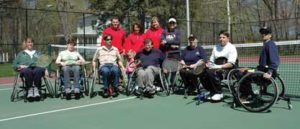 “Learning how to play tennis is the same for everyone no matter their ability,” said Paul Brower, a USTA professional who has been teaching tennis for 20 years and also is the coach for the Connecticut Hornets, the Sports Association’s competitive team. “You learn the proper way to hold the racquet and learn the basic strokes. Most beginners are up and going in a few weeks.”
“Learning how to play tennis is the same for everyone no matter their ability,” said Paul Brower, a USTA professional who has been teaching tennis for 20 years and also is the coach for the Connecticut Hornets, the Sports Association’s competitive team. “You learn the proper way to hold the racquet and learn the basic strokes. Most beginners are up and going in a few weeks.”
“As long as they can move their chair and arms, they can play tennis. We even have quads that play,” Brower said.
Gripping the Racquet
Chair users need to learn to grip the racquet differently than able-bodied players because they need to hold the racquet and push the chair at the same time. Many beginners want to keep the racquet in their lap while they push, but that results in not being ready to return the ball from the opponent.
“A player has to learn how to push the chair with the heel of the hand and the inside of the racquet grip, so the racquet is up and ready,” said Karen Smith, team captain of the Connecticut Hornets.
 The racquet is held in the dominant hand with four fingers, leaving the thumb free. This leaves the pad of the hand free, giving the player a contact point with the wheel or push rim. But the free hand does the majority of the work on the court, because it is pushing and turning the chair constantly to get into the best position to return the ball.
The racquet is held in the dominant hand with four fingers, leaving the thumb free. This leaves the pad of the hand free, giving the player a contact point with the wheel or push rim. But the free hand does the majority of the work on the court, because it is pushing and turning the chair constantly to get into the best position to return the ball.
For quadriplegics who do not always the arm strength to grip the racquet, they can still play by using athletic tape, or a gripping device to secure the racquet in their hand and forearm.
Serving
The strategy for returning serves varies slightly from able-bodied players as chair users typically don’t play the net. “It’s easy to lob over someone’s head, so many wheelchair players stay further behind the base line for more slice and more drop shots, much like able-bodied team players do,” Brower said.
The Hub
Moving around the court involves three basic stages – react, negotiate and recover with a point in the court called “the-hub” key to mastering the game. The hub is typically five feet behind the base line and is the point the player uses to react and recover after each stroke.
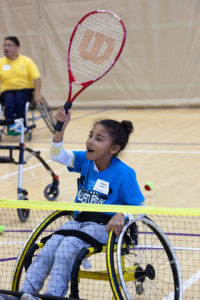 “For wheelchair users, that’s the effective way to play, behind the base line, because then you can come in for shots or go wide for a second bounce,” said Smith. “If you stay at the net, you won’t be able to return long shots.”
“For wheelchair users, that’s the effective way to play, behind the base line, because then you can come in for shots or go wide for a second bounce,” said Smith. “If you stay at the net, you won’t be able to return long shots.”
Smith said wheelchair users new to the game need to understand the importance of the hub and how to move into and out of it.
“As a player, after coming in for the shot, you then recover quickly and get back to the hub,” she said. “You are always going back and forth. It’s all about quick movement.”
Players start out at the hub and react and move toward the ball. The player negotiates the stroke (hits the ball), and then recovers toward the hub by turning his chair toward the middle of the court at an angle to provide a clear view of the opponent. Just before the opponent is about to hit the ball, the player turns into the court, ready to react to the next ball.
“As wheelchair users we have poor lateral motions,” Smith said. “As tennis players, we have to be in constant motion. I like to say we are like a shark in water. A shark has to keep moving or it will die. In wheelchair tennis, players have to keep moving or they won’t be able to get to the ball.”
Chair users know that the head is always the first part of the body to move in the direction they want their chair to move.
“The most important part is to turn with your head, because your body follows. Learn to push with the heel of your hand so the racquet is up and ready. Retreat back at an angle so you can watch your opponent over your shoulder,” she advised. “Always remember to get a quick start, stay in constant motion, and lead with the head.”
Adaptations and Equipment
To make learning and participating in tennis a fun and challenging experience right from the start, there are several adaptations to the game that can be made, as well as various adaptive equipment that its available.Tennis rackets: Rackets come in a variety of shapes and sizes, including ones that are shorter, smaller, and lighter, which make gripping the racket and hitting the ball easier, especially if range of motion is an issue. Sometimes athletic tape or a gripping device to secure the racquet to the hand and forearm is used.
Two bounce rule: Allows the ball to bounce twice before a return volley.
Tennis balls: There are numerous kinds of tennis balls that vary in size and compression. Larger tennis balls are easier to hit and lower compression means that tennis balls will move more slowly and be less likely to bounce over your head, allowing rallies to last longer.
Tennis courts: Even courts can be reconfigured for adaptive tennis play. For instance, reducing the playing area means longer points and more fun. Lower tennis nets and portable nets are also available to modify the playing areas to whatever works best for learning and playing, even off the tennis court on a flat surface like a blacktop, driveway, or playground. There are also swing tee stands to practice stroke mechanics.
Wheelchairs for Tennis: Special wheelchairs with cambered wheel are used for better stability and maneuvering.
When learning the basics of tennis, an everyday wheelchair can suffice, but as players become serious about the sport, most opt to invest in a wheelchair made for court sports.
A sports chair provides a player more agility, faster response and turning quickness.
“The difference between a sports chair and a standard chair is it’s very lightweight. With no armrests, no brakes, no push handles, essentially nothing to get in the way of the swing,” said Munn.
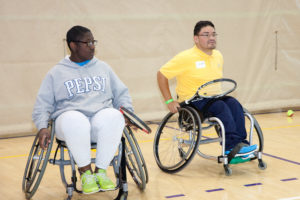 “Sports chairs typically have only one front caster, similar to a roller blade,” he said. “There is also an anti-tip wheel in the rear that is sometimes used to help power a serve. Some newer models now have two front casters and/or anti-tippers. The large wheels of the chair are cambered to allow a quicker turning radius.
“Sports chairs typically have only one front caster, similar to a roller blade,” he said. “There is also an anti-tip wheel in the rear that is sometimes used to help power a serve. Some newer models now have two front casters and/or anti-tippers. The large wheels of the chair are cambered to allow a quicker turning radius.
“But a beginner doesn’t need a sports chair right away. It’s a big investment. Usually the wheelchair athlete will play for one to two years before they make the purchase. They get more involved, depending on their commitment level and have learned what specifics they want on their own sports chair,” said Munn.
Munn added that amputees can also play wheelchair tennis, as long as it is in the chair.
“We don’t require anyone be in a chair for all activities,” Munn said. “Sometimes an amputee is ambulatory but will use the chair for play. The only requirement to be a wheelchair player is that you cannot play able-bodied tennis.”
Karen Smith of East Haven, Conn., played tennis only occasionally as an able-bodied person. But her interest in the sport peaked after she found herself relying on a wheelchair as her Multiple Sclerosis progressed. She now has been playing serious wheelchair tennis for more than 10 years, and is the team captain for the Connecticut Hornets, sponsored by the Sports Association, Gaylord Hospital, Wallingford, Conn.
“Playing tennis, or any adaptive sport, gets you back to where you were before you became disabled,” she said. “One of the great things about tennis is you can play with your able-bodied friends. The only rule difference is the wheelchair player gets two bounces of the ball, compared to the able-bodied one.”
“Wheelchair tennis is an activity you can do with anyone,” said Pamela Lehnert, Ctrs, executive director of Baltimore Adapted Recreation and Sports (Bars), a Dsusa chapter.
“It’s not possible to play wheelchair basketball or baseball with the able-bodied, because the able-bodied person may get injured by the chair,” she said. “But tennis lets the able-bodied and wheelchair players compete against each other or even be teammates in mixed doubles.”
Tennis offers many benefits to participants. Besides the social aspect of being able to play the same game with able-bodied friends or family, tennis stimulates tactical thinking, builds confidence, improves hand-eye coordination, provides aerobic activity, and is just plain fun.
Levels of Play
Paralympic ClassificationThere are two classifications in wheelchair tennis based on the International Paralympic Committee’s classification system.
- Open: Player has a significant and permanent impairment of one or both legs and normal arm function. Athletes who would be in this class are athletes with paraplegia or leg amputations.
- Quad: Player has an impairment affecting his playing arm as well as his legs, limiting his ability to handle the racket and to move in the wheelchair. Athletes in this class may use tape to securely grip the racket.
To learn more about the classification system for wheelchair tennis, visit the U.S. Paralympics’ wheelchair tennis classification page or the International Paralympic Committee’s wheelchair tennis classification page.


